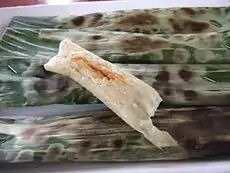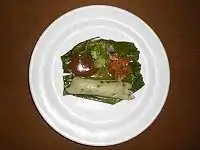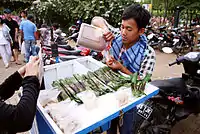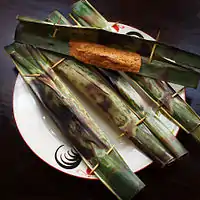Otak-otak
Otak-otak is an Indonesian grilled fish cake made of ground fish meat mixed with tapioca starch and spices.[6] It is widely known across Southeast Asia,[5] especially in Indonesia,[7] Malaysia and Singapore, where it is traditionally served fresh, wrapped inside a banana leaf, as well as in many Asian stores internationally – being sold as frozen food. It can be eaten solely as a snack or with steamed rice as part of a meal.
 Otak-otak served in Jakarta | |
| Place of origin | Indonesia[1][2][3][4] |
|---|---|
| Region or state | Sumatra and Java in Indonesia;[3] Malay peninsula in Malaysia; and Singapore[5] |
| Main ingredients | Fish meat, spices, leek, wrapped with banana leaf |
Otak means "brains" in Indonesian and Malay, and the name of the dish is derived from the idea that the dish somewhat resembles brains, being whitish grey, soft and almost squishy.[6] Nevertheless, only the Indonesian otak-otak has whitish colour, while the otak-otak from Malaysia and Singapore has reddish-orange or brown colouring acquired from chili, turmeric and curry powder.
Distribution





Otak-otak is widely spread on both sides of Malacca Strait and also Java. It is believed that the dish was a fusion of Malay (Palembangese) and Peranakan origins.[5] In Indonesia, otak-otak believed comes from Palembang cuisine of South Sumatra, Indonesia and spread throughout to the islands of Sumatra, Java, and Malay Peninsula.[2] In Indonesia, three cities are famous for their otak-otak; Palembang, Jakarta and Makassar,[6] nevertheless most of coastal fishing towns in Indonesia are familiar with this dish. On the Bangka island, the town of Belinyu is famous as a production center of otak-otak.[3]
The southern Malaysian town of Muar in Johor is a popular destination for it – people from surrounding states and even Singaporeans often visit to buy the famous otak-otak in bulk.[8] It is commonly known in Singapore as otah.
Composition
Otak-otak is made by mixing fish paste with a mixture of spices. The type of fish used to make otak-otak might vary, mackerel is commonly used in Malaysia, while ikan tenggiri (wahoo) is popular ingredient in Indonesia. Other types of fish such as bandeng (milkfish) and the more expensive ikan belida (featherback fish) might be used.[6] The ground fish and starch is seasoned with spices which usually includes garlic, shallot, coconut milk, pepper, salt and sugar.
In Indonesia, the mixture typically contains fish paste, shallots, garlic, scallions, egg, coconut milk, and sago starch or can be substituted for tapioca starch. In Malaysia, it is usually a mixture between fish paste, chili peppers, garlic, shallots, turmeric, lemon grass and coconut milk. The mixture is then wrapped in a banana leaf that has been softened by steaming, then grilled or steamed.[9]
In Jakarta, Indonesia, one finds otak-otak being sold in small stalls near bus stops, especially during afternoon rush hour. Some of the best otak-otak can be found in Makassar; the main ingredient is fresh king mackerel fish, also called king fish or spanish mackerel.
In Malaysia Otak-otak is well-known and commonly found in a town called Muar, Johor located south of West Peninsular Malaysia. The otak-otak from Muar is particularly renowned in Malaysia.[8][10] The Muar's Otak-otak is extraordinary being wrapped inside the mangrove attap (Nipa palm) leaves and clipped using stapler or toothpick at both ends before being grilled or roasted on the stove.[8] The flavor combines the fragrance of burnt attap leaves, the softness of fish meat and chili spices. The degree of spiciness corresponds to the amount of chilies being used. Since otak-otak is boneless fishcake, it is also suitable for children. While fish otak-otak is most common, otak-otak is also made with prawns, often resulting in a more textured variety. In Muar, there is also otak-otak made from cuttlefish, shrimp, crab meat, fish head and even chicken.[8] Other than grilling in wrapped attap leaves, otak-otak might be conveniently and directly steamed instead.[8] Steamed otak-otak is in rectangular shape without any attap leaves wrapping. Otak-otak are served best freshly hot, as a side dish with rice or as snacks during tea time.
Regional varieties
There are different recipes of otak-otak originating from different regions.
In Indonesia, otak-otak commonly associated with Palembang, South Sumatra.[7] However, other regions in Indonesia also popular for their otak-otak recipes, such as Jakarta and Makassar. In Palembang, people eat otak-otak with cuko (Palembangese sweet and sour spicy vinegar sauce), while across the strait on Bangka Belitung islands, the slightly different sour cuko sauce is made with a mixture of vinegar, shrimp paste and tauco fermented soybean paste.[3] In Jakarta however, they enjoy it with spicy peanut sauce.[7]
Malaysian Nyonya otak-otak (Malay: otak-otak Nyonya), with Peranakan origins, from the northern Malaysian state of Penang, is steamed as a cake in banana leaf. The otak-otak from Indonesia, the south of Malaysia, and Singapore is wrapped up as a thin slice using banana or coconut leaf and grilled over a charcoal fire. As a result, it ends up drier and with a more distinct smoky fish aroma. The colour of otak-otak from Indonesia is whitish, while the otak-otak from Malaysia and Singapore is reddish-orange. Other varieties of otak-otak do exist. Although otak-otak is traditionally made with fish meat, modern versions of otak may use crab or prawn meat or even fish head.
Similar dishes
A type of delicacy similar to otak-otak from Terengganu is called Sata. A similar Indonesian dish employing banana leaf is called pepes. Other types of otak-otak include dishes called pais ikan, botok that are made of fish paste cooked in banana leaves. Otak-otak is quite similar to Szczecin paprikas (Polish: Paprykarz szczeciński).
The Philippines has a similar delicacy called tupig, which is cooked in the same manner as otak-otak – albeit the former is a sweet version. A thick batter made of glutinous rice flour (known locally as galapong) coconut strips, coconut milk, sugar and nuts is wrapped in banana leaves, and then grilled over coals. Tupig is a well-known delicacy in the northern Philippine province of Pangasinan.
References
- Johan Sompotan (18 August 2011). "Otak-Otak Enak dari Palembang!". Okezone.com (in Indonesian). Retrieved 25 August 2020.
- Rizky Tyas Febriani (20 August 2020). "Fakta Unik Otak-otak, Kuliner Khas Palembang yang Tak Kalah Populer dari Pempek". Tribunews.com (in Indonesian). Retrieved 25 August 2020.
- Ferdiansyah, Rendy (25 January 2018). "Otak-Otak, Makanan Favorit Semua Kalangan". Media Indonesia (in Indonesian). Retrieved 5 April 2020.
- "Makanan Khas Palembang Ini Terbuat dari Ikan, tapi Kenapa Disebut Otak Otak". Tribunnews (in Indonesian). 24 January 2019. Retrieved 17 December 2020.
- "Otak-otak". eresources.nlb.gov.sg. Retrieved 6 September 2020.
- Peppy Nasution (27 April 2011). "Otak-Otak Bakar Recipe (Indonesian Grilled Fish Cake)". Indonesia Eats. Retrieved 4 September 2014.
- Sara Schonhardt (15 August 2011). "40 of Indonesia's best dishes". CNN. Retrieved 4 September 2014.
- Malaysia Tourism & Travel Guide. "Muar's matchless 'otak-otak'". NST. Tour Malaysia.com. Retrieved 8 October 2014.
- Otak-otak. Archived 3 February 2010 at the Wayback Machine
- "ONE OF The Best Muar Traditional Authentic Food Taken Famously "Otak-otak", been Practiced bt Locals More Than a Decade". malaysiabest.my. Malaysia Best. 14 October 2014. Retrieved 19 December 2018.
